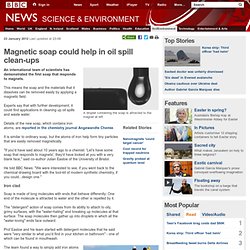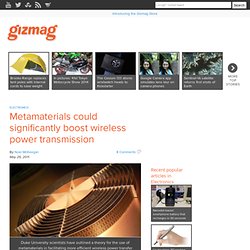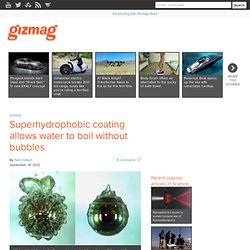

Magnetic soap could help in oil spill clean-ups. 23 January 2012Last updated at 23:09 A droplet containing the soap is attracted to the magnet at left An international team of scientists has demonstrated the first soap that responds to magnets.

This means the soap and the materials that it dissolves can be removed easily by applying a magnetic field. Experts say that with further development, it could find applications in cleaning up oil spills and waste water. Details of the new soap, which contains iron atoms, are reported in the chemistry journal Angewandte Chemie. It is similar to ordinary soap, but the atoms of iron help form tiny particles that are easily removed magnetically. Harder than diamond, stronger than steel. Graphene could help build a new generation of electronic devices, such as touch screens, solar panels and superfast computers.

Image: AlexanderAlUS/Wikimedia Imagine a material that is just one atom thick, 300 times stronger than steel, harder than diamond, a fantastic conductor of heat and electricity and super-flexible to boot. This might sound like the stuff of science fiction, but believe it or not, such a material already exists. Laser 'unprinter' wipes photocopied ink from paper. 15 March 2012Last updated at 11:46 ET A close-up image of a sheet of "unphotocopied" paper reveals most of the toner has been removed A process to "unphotocopy" toner ink from paper has been developed by engineers at the University of Cambridge.

The process involves using short laser pulses to erase words and images by heating the printed material to the point that they vaporise. Super-polluted city tries to clean itself with smog-eating paint. Scientists capture carbon dioxide with NOTT-202. Science journal Nature Materials has reported that a consortium of scientists from the universities of Nottingham and Newcastle have collaborated with members from the Oxfordshire Diamond Light Source and the Science and Technology Facilities Council’s Daresbury Laboratory have created a sponge-like material, known as “NOTT-202”.

NOTT-202 works by absorbing gasses under high pressure and releasing most of them back out into the atmosphere again once the pressure becomes lowered. The crucial factor is how the ‘sponge’ retains harmful greenhouse gases, such as CO2, reportedly a leading component of climate change. The idea of using a metal organic framework to capture and store gases has been around for several years; however the difficulty comes from selectively targeting just CO2.
New holey material soaks up CO2. 12 June 2012Last updated at 06:42 ET Two interlocking but not completely overlapping structures leave room for gases UK researchers have developed a porous material that can preferentially soak up CO2 from the atmosphere.

Metamaterials could significantly boost wireless power transmission. The weird properties of artificially engineered metamaterials are at the core of research into invisibility cloaking, but engineers from Duke University in North Carolina suggest that these materials could also provide a boost to another of technology's quests - wireless power transmission.

In this latest hard-to-get-your-head-around metamaterial scenario, it's not the cloaked object that "disappears" - it's the space between the charger and the chargee. Close-range wireless charging of mobile devices has become a reality for consumers in recent times but there's room for improvement, particularly if bigger fish - like electric vehicles - are to be caught in the wireless-power net. The problem with transmitting small amounts of power over longer distances is that most of it will be scattered before it reaches the receiving device. And if you up the energy, radiation becomes a problem. Nanomaterial dust is more explosion-prone that normal dust. In 2008, a sugar refinery in Portwentworth, Georgia exploded, killing 13 people and injuring 42 others. The culprit was a dust explosion. That's the violent combustion of extremely fine particles when they're suspended in an enclosed location's air.
Coal, wheat flour, cornstarch and other types of dust can be hazardous in certain industries. These sorts of explosions have been recorded since 1785, so we now know quite a bit about the combustible properties of dust. But dust, according to the US National Fire Protection Association (NFPA), is defined as a finely divided solid with a diameter of less than 420 μm -- those are micrometres. Researchers from Dalhousie University in Halifax, in an study for the American Chemical Society's journal Industrial & Engineering Chemistry Research, probed these smaller "nontraditional" dusts to see how they compare to old fashioned wheat and sugar.
Cost of gene sequencing falls, raising hopes for medical advances. (Credit: Silky M/Wikimedia Commons) In Silicon Valley, the line between computing and biology has begun to blur in a way that could have enormous consequences for human longevity.

Bill Banyai, an optical physicist at Complete Genomics, has helped make that happen. Synthetic biology - no worries? (item 5) News Alert Issue 288, 15 June 2012 Science for Environment Policy About this service Contact the Editor Subscribe to this News Alert In this issue Extending ozone treaty would support GHG reduction goals Extending the Montreal Protocol on ozone-depleting substances to include hydrofluorocarbons (HFCs) could have important benefits for climate change action, say scientists in a recent analysis.

Raising the profile of soil’s essential contribution to society Soils play a vital role in the Earth's life-support system, yet their importance and value to society is not always recognised. Researchers identify sterility genes in hybrid rice - Physorg. Nanofactories – a future vision. Nanotechnology scientists are developing materials which mimic nature.

Photograph: Science Photo Library Mimicking nature is a recurring theme in nanotechnology and molecular nanotechnology, inspired by the natural nanostructures found in our own bodies, offers many exciting potential outcomes. "Molecular nanotechnology is the expected ability to build our products with molecular-level precision, as nature can do," says Christine Peterson, president of the Foresight Nanotech Institute in California. "It will bring unprecedented quality, energy efficiency and environmental sustainability". Superhydrophobic coating allows water to boil without bubbles. You know that thing that water does when it boils?

The thing with the bubbles? Turns out, it doesn't really need to do that at all, with scientists finding a way to make boiling water a completely bubble-free zone. Researchers from Northwestern University, King Abdullah University of Science and Technology in Saudi Arabia and Melbourne University in Australia teamed up to prevent water from bubbling when it boils by using tiny spheres coated with a hydrophobic material.
The breakthrough is thanks to a little thing called the Leidenfrost effect. When a liquid (say, water) comes into contact with a surface above the Leidenfrost threshold temperature, instead of simply bubbling and evaporating completely away, an insulating layer of vapor is created that protects the majority of the liquid from the searing surface temperatures. Until now, it's been scale that has prevented the effect being used more widely. Superhydrophobic Coating Allows Boiling Water without the Creation of Bubbles. Water can be made to boil without any bubbling if a boiling surface is specifically treated so that the vapor cushion does not break down.
This is linked to the Leidenfrost effect. The scientists published their findings in the journal Nature.